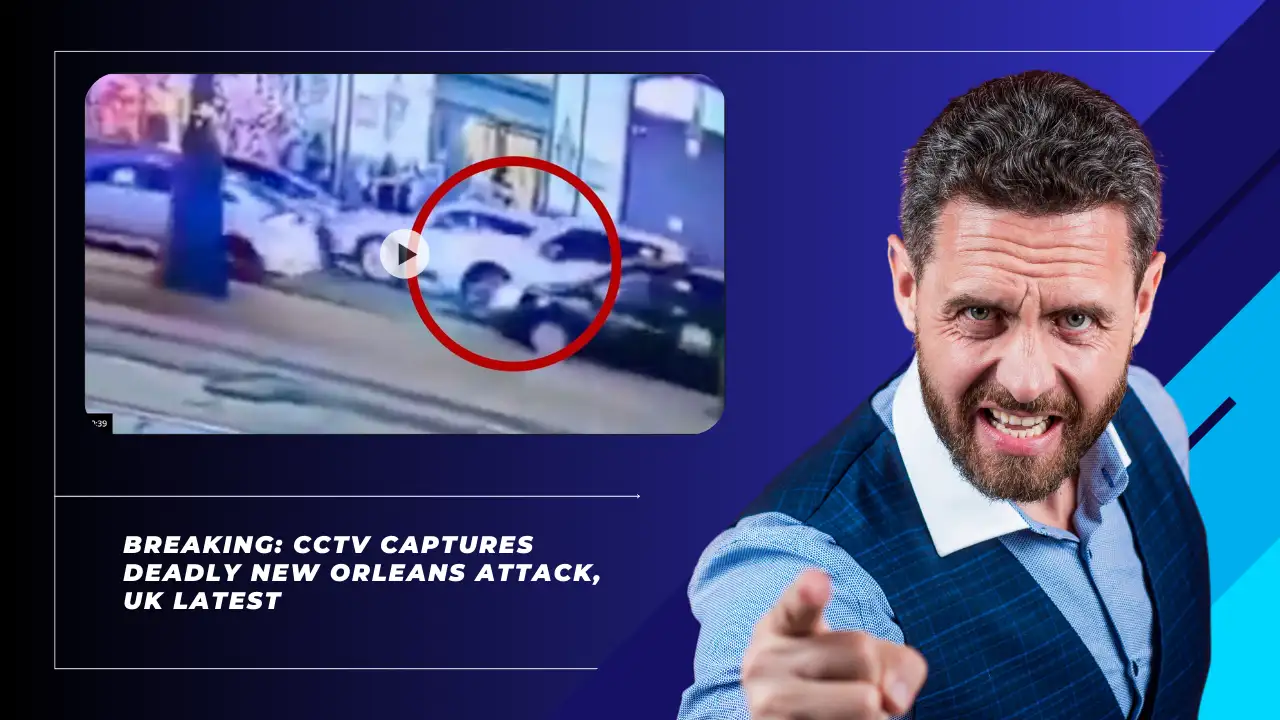Breaking: Deadly New Orleans Attack Sparks Global Security Alert
Breaking CCTV footage reveals the deadly attack in New Orleans that claimed multiple lives yesterday. Initially captured at 2:15 PM local time, the security cameras documented suspect Shamsud-Din Jabbar’s truck breaching protective barriers near the French Quarter. As a result of this incident, we’re tracking significant developments in the latest news in the UK, where authorities have raised security alerts across major cities.
The attack has triggered an international response, particularly affecting what’s the latest news in the UK regarding counter-terrorism measures. Security officials from both nations are currently coordinating their efforts, while the FBI has launched a comprehensive terrorism investigation. We’ve gathered critical information about the unfolding situation, including detailed timeline analysis, casualty reports, and the broader implications for global security.
Breaking Timeline of New Orleans Attack
FBI surveillance footage reveals a meticulously planned attack that unfolded across multiple locations in New Orleans’ French Quarter. Subsequently, we examine the detailed timeline of events that led to this tragic incident.
Initial CCTV footage analysis
Security cameras captured Jabbar conducting surveillance of the area between 1:00 AM and 2:00 AM on New Year’s Day. Furthermore, video evidence shows him placing two improvised explosive devices in coolers throughout the French Quarter. The suspect posted five videos to Facebook between 1:29 AM and 3:02 AM.
Moment truck breached barriers
At approximately 3:15 AM, CCTV footage documented the white Ford F-150 truck circumventing police barriers at Canal Street. The vehicle, which had been rented six weeks prior, proceeded to travel nearly two and a half blocks up Bourbon Street. Consequently, the truck crashed between Bienville and Conti streets.
Emergency response timeline
The emergency response unfolded rapidly:
- 3:17 AM: Officers responded to initial reports of the vehicle striking multiple pedestrians
- 3:20 AM: Police engaged in gunfire with the suspect
- 5:18 AM: New Orleans Fire Department responded to a fire at the suspect’s rental property
The FBI’s investigation revealed critical evidence at multiple locations:
- Two functional IEDs discovered in coolers near the attack site
- Bomb-making materials found at the Mandeville Street rental property
- A transmitter intended for detonating the IEDs located in the truck
The FBI has accordingly deployed more than 200 additional personnel to assist in the investigation. Law enforcement officials continue analyzing terabytes of video data from the New Orleans Real Time Crime Center. The investigation remains active as authorities process evidence and interview survivors.
Suspect Profile and Investigation
We have uncovered extensive details about the suspect behind this devastating attack. The FBI has identified him as Shamsud-Din Jabbar, a 42-year-old U.S. citizen from Texas.
Background of Shamsud-Din Jabbar
A thorough investigation reveals Jabbar’s complex history. He served in the U.S. Army for more than a decade, completing an 11-month deployment in Afghanistan and earning a global war on terrorism service medal. After his military service, he pursued higher education at Georgia State University from 2015-17, obtaining a degree in computer information systems.
His professional life included positions at prominent firms. Notably, he worked at Deloitte starting in 2021 and held positions at Ernst & Young. Nevertheless, recent years showed signs of personal turmoil. Court records indicate significant financial difficulties, with monthly expenses exceeding his income.
FBI terrorism investigation details
The FBI has discovered critical evidence linking Jabbar to terrorist organizations. Most significantly, investigators located an ISIS flag in the vehicle. During the attack, the suspect wore Meta smart glasses, apparently using them to document the incident.
Key evidence collected includes:
- Three phones and two laptops under examination
- Two active explosive devices in coolers
- AR-15-style weapon and a handgun
- Body armor worn during the attack
Potential accomplices search
Presently, the FBI has deployed more than 200 additional personnel to assist in this investigation. The search spans multiple locations, with authorities pursuing leads in:
- Houston
- Atlanta
- Tampa, Florida
Although initial evidence suggests Jabbar acted alone in New Orleans, investigators continue examining potential connections both domestically and internationally. The FBI’s Counterterrorism Division, along with the Critical Incident Response Group and Hostage Rescue Team, are working around the clock to process evidence and interview associates.
Victim Impact and Casualties
The devastating attack in New Orleans’ French Quarter has left an indelible mark on countless lives. We can now confirm that fourteen innocent people lost their lives in this tragic incident, with dozens more injured.
Casualty statistics and demographics
The victims ranged in age from 18 to 63, with most being in their 20s. Moreover, the FBI has identified 35 known injured individuals, with this number expected to rise as more people seek medical attention. Among those who lost their lives were:
- LaTasha Polk, 47, a nursing assistant and mother of a teenage son
- Edward Pettifer, 31, a British citizen from London
- Nikyra Dedeaux, 18, an aspiring nurse
- Martin “Tiger” Bech, 27, a former Princeton University football star
Eyewitness accounts
Undoubtedly, the accounts from those present paint a horrific picture of the events. Jim and Nicole Mowrer, visitors from Iowa, witnessed the white truck slam through a barricade at high speed. Additionally, witness Kevin Garcia described the terrifying moment when “a body came flying at me”.
Whit Davis, who was leaving a nightclub at the time, reported seeing “dead bodies they couldn’t even cover up and tons of people receiving first aid”. Another witness, Mr. Cothran, observed from a nightclub balcony as the pickup truck barreled past at approximately 70 mph, with only “flimsy” barricades in place to protect pedestrians.
Hospital response efforts
The University Medical Center (UMC) mounted an unprecedented emergency response. Dr. Jeffrey Elder reports this was the highest number of critical patients the hospital has seen in the region for some time. The medical response included:
| Response Element | Details |
|---|---|
| Total Patients | 30 treated at UMC |
| Current Status | 13 still receiving care |
| Injury Types | Gunshot wounds, blunt injuries, broken limbs, head trauma |
| Medical Support | LSU and Tulane medical schools provided additional trauma surgeons |
The hospital staff continues providing resources to patients and their families. Specifically, the medical team has implemented a comprehensive care plan, ensuring all victims receive necessary physical and psychological support throughout their recovery journey.
Security Analysis
Our investigation into the French Quarter’s security infrastructure reveals critical gaps that enabled this tragic attack. In fact, a confidential security assessment from 2019 had explicitly warned about the risk of vehicle attacks, rating them as “highly possible”.
French Quarter protection measures
We discovered that three distinct types of protective barriers were notably absent on New Year’s Day. The city owned 700-pound steel Archer barriers, which could have stopped even speeding vehicles by wedging under them. These barriers, purchased as part of a £31.77m public safety package in 2017, were not deployed due to their perceived deployment complexity.
Police barrier effectiveness review
The existing security measures proved inadequate. Indeed, the bollard system installed on Bourbon Street in 2017 had deteriorated significantly:
- Original bollards rated for 40mph impacts became clogged with Mardi Gras beads
- Replacement bollards only rated for 10mph impacts
- Single patrol cruiser blocking road entrance proved insufficient
The city had received state funding in November to replace the bollards, therefore the work remained incomplete during the attack. A table comparing the security measures reveals:
| Security Measure | Status During Attack | Intended Protection Level |
|---|---|---|
| Archer Barriers | Not Deployed | High (700lb steel) |
| Original Bollards | Removed | Medium (40mph rated) |
| Replacement Bollards | Incomplete Installation | Low (10mph rated) |
Future security recommendations
Certainly, officials have outlined comprehensive security enhancements. The mayor has requested:
- Tactical expert review of safety plans for:
- Super Bowl (February 9)
- Mardi Gras (March 4)
- Federal upgrade from Tier Two to Tier One security status for Mardi Gras
Security experts like Juliette Kayyem emphasize that “between barriers, bollards and sanitation trucks and other things, it would have been relatively simple to make Bourbon Street more secure for any mega event”. Cities worldwide have implemented effective measures – Chicago uses concrete flower beds on Magnificent Mile, ultimately creating robust protection against vehicle attacks.
The governor has issued an emergency declaration activating the National Guard to strengthen security. In response to what’s the latest news in the UK regarding similar threats, we note that British authorities are closely monitoring these developments as they reassess their own urban security protocols.
International Response
Global leaders have united in condemning the New Year’s Eve attack in New Orleans, as we witness an unprecedented wave of international solidarity. Meanwhile, what’s the latest news in the UK shows heightened security measures being implemented across major cities.
UK government reaction
British Prime Minister Keir Starmer expressed profound concern, stating that “the shockingly violent attack in New Orleans is horrific”. The UK Foreign Office has promptly issued updated travel advisories for British citizens planning visits to the United States.
Key measures implemented by UK authorities include:
- Enhanced security at major public gatherings
- Updated emergency response protocols
- Increased coordination with US intelligence services
Global security implications
Notably, the international community has responded swiftly to this tragic event. A comprehensive overview of global reactions reveals:
| Country | Official Response | Key Actions |
|---|---|---|
| Germany | Chancellor Scholz condemned “senseless hatred” | Enhanced city security |
| Ukraine | President Zelensky pledged solidarity | Intelligence sharing |
| Israel | Foreign Minister expressed condolences | Counter-terrorism support |
| Turkey | Called for swift investigation | Security cooperation |
Similarly, the European Union’s top diplomat, Kaja Kallas, emphasized that “there is no excuse for such violence”. Ultimately, this attack has prompted a reassessment of security measures worldwide, especially regarding the protection of crowded public spaces.
Counter-terrorism cooperation
The FBI’s investigation has uncovered significant links to international terrorism networks. We have learned that the suspect had pledged allegiance to ISIS through social media posts. Henceforth, this has triggered enhanced international counter-terrorism cooperation:
- Intelligence Sharing
- Real-time threat assessment updates
- Joint digital surveillance operations
- Coordinated response strategies
- Technical Cooperation
- Advanced detection systems deployment
- Cross-border investigation support
- Shared database access
The attack has highlighted what experts call the “Digital Caliphate” – a new phase in ISIS’s technological evolution. This virtual network has become increasingly sophisticated in orchestrating attacks through digital means, prompting international security agencies to adapt their counter-strategies.
Saudi Arabia and multiple other nations have officially denounced the attack, leading to strengthened diplomatic ties focused on counter-terrorism efforts. The FBI, as the lead investigative agency, is coordinating with international partners to investigate potential global connections.
In response to next news developments, we’re seeing unprecedented levels of information sharing between allied nations. The investigation has revealed that the attacker had traveled extensively, using Meta smart glasses to conduct surveillance, underscoring the need for enhanced international monitoring of suspicious activities.
Conclusion
This devastating New Orleans attack stands as a stark reminder of modern terrorism’s evolving threats. Above all, the loss of fourteen precious lives and numerous injuries highlight critical security vulnerabilities that demand immediate attention. The suspect’s military background, coupled with sophisticated planning, undoubtedly exposed weaknesses in urban security infrastructure.
The French Quarter attack has triggered worldwide security reassessments. Meanwhile, law enforcement agencies worldwide have strengthened their counter-terrorism partnerships, sharing vital intelligence and resources. British authorities lead these efforts, implementing enhanced security protocols across major UK cities.
Security experts now emphasize the urgent need for robust physical barriers and advanced surveillance systems. Therefore, cities worldwide must upgrade their protection measures, particularly during large public gatherings. The international community’s swift response and unprecedented cooperation consequently pave the way for stronger global security frameworks.
The lessons learned from this tragic event will shape future security strategies. Law enforcement agencies continue their relentless pursuit of justice, while cities worldwide strengthen their defenses against similar threats. These coordinated efforts mark a significant step toward safer public spaces and more effective counter-terrorism measures.


